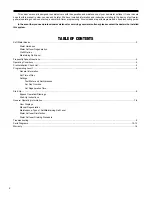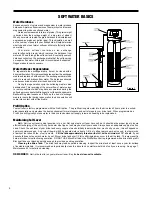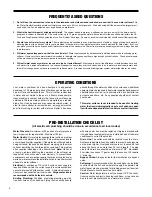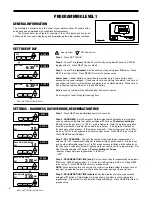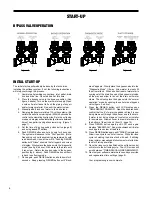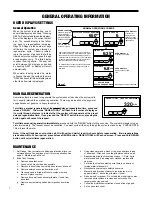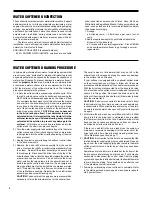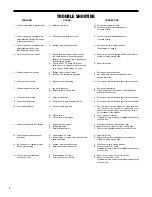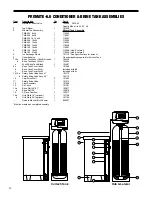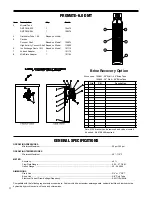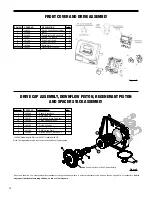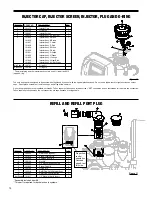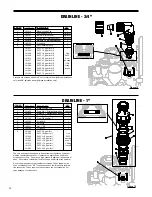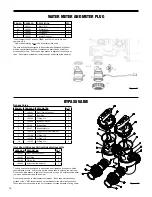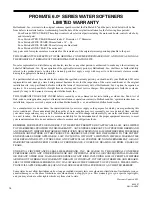
4
1. Do I still use the same amount of soap in the dishwasher and clothes washer and showers now that I have a water softener? No,
the Water Quality Association states soft water can save up to 55% on detergent use. Start with using half the amount of detergent previ-
ously used, this can be adjusted up or down based on preference.
2. What is the health impact of drinking soft water? The sodium added to water by a softener is a non-issue most of the time, even for
people on a sodium-restricted diet. One could soften up to 75 grains per gallon water with sodium chloride and still be well within the US
Food and Drug Administration’s guidelines for a “Low Sodium” beverage. People on a sodium-restricted diet should consult their physician.
3. Should I use soft water for my plants? Some plants may be sensitive to even minute amounts of sodium. Suggest using hard water for
watering plants, often a kitchen cold faucet is plumbed for hard water or the outside faucets are usually plumbed for hard water. If not, you
can place your softener on bypass and fill water containers at the closest sink. Water from a reverse osmosis system can always be used
to water plants.
4. Will water spots disappear now that I have soft water? Water spots caused by hardness scale will disappear with a functioning water
softener. However, other natural minerals dissolved in the water may cause spotting in high enough concentrations. These mineral spots
will be much easier to wipe away compared to hardness spotting.
5. Will soft water cause my water or ice cubes to look or taste different? Most people can tell the difference in taste between hard and
soft water, it is a personal preference. Ice cubes will appear the same, they may look cloudy due to air in water or dissolved minerals, and
this will not change because they are made with softened water. A reverse osmosis drinking water system will provide clearer ice cubes.
frequenTly asked quesTions
oPeraTinG CondiTions
Your water conditioner has been designed to adequately
handle up to 100 grains per gallon of hardness as well as up to
2 ppm of ferrous bicarbonate iron. This is iron that is dissolved
in water and not visible to the eye in a freshly drawn sample.
Upon standing in contact with air, the ferrous iron will become
oxidized to the ferric state and start to precipitate as a reddish
brown floc. It can be seen and may cause discolored water. In
order for your softener to remove the iron, air (oxygen) must be
kept from coming in contact with water until after it has been
passed through the water conditioner. In some cases, additional
equipment may be required to treat water supplies having special
characteristics, such as: ferric hydroxide iron, iron bacteria, low
pH, taste and odors, etc. If any question should exist, contact
your dealer.
This water softener is not intended to be used for treating
water that is microbiologically unsafe or of unknown qual-
ity without adequate disinfection before or after treatment.
Water Pressure: A minimum of 25 pounds of water pressure
(psi) is required for regeneration. Maximum 125 psi.
Water Quality: On rural water supplies there is often a problem
with sand or sediment in the water. (This problem occasionally
occurs in public water supplies.) If the water is not filtered before
being softened, the sand and sediment may plug up the water
softener restricting the flow through the resin bed. This problem
often requires rebedding of the mineral tank.
Note: Well and/
or pump problems affecting the operation of the softener are
repairs that are not covered under warranty. To prevent these
unnecessary, and expensive repairs that are not covered under
warranty, we recommend the installation of an in-line filter system
ahead of a water softener.
Electrical: A continuous 110 volt 60 cycle current supply is
required.
Make certain the current supply is uninterrupted and
cannot be turned off with another switch. All electrical connec-
tions must be connected per local codes. Surge protection is
recommended with all electric controls.
Existing Plumbing: Condition of existing plumbing must be
free from lime and iron build-up. Piping that is built-up heavily
with lime and/or iron must be replaced. If piping is blocked with
iron, additional equipment must be installed ahead of the water
conditioner to correct the problem.
Drain Line: The softener should be located close to a drain.
Avoid overhead drain lines if possible to prevent back pressure
on the brine injector. Overhead drains are not to exceed 8 feet
above the floor and no more than 20 feet in length. The pipe
size for the drain line should be a minimum of 3/4”. Backwash
flow rates in excess of 7 gpm or length in excess of 20’ require
1” drain line.
Bypass Valves: Always provide for the installation of a bypass
valve.
Softening: It is recommended that the conditioner be installed
to soften both the hot and cold water supply. A separate hard
water faucet may be plumbed for drinking purposes if desired.
Outside faucets should be left on hard water.
Caution: Water temperature is not to exceed 110°F; the condi-
tioner cannot be subject to freezing conditions, or to a vacuum
due to loss of pressure (such as a water main break).
Pre-insTallaTion CHeCk lisT
(All electrical & plumbing should be done in accordance to all local codes)


